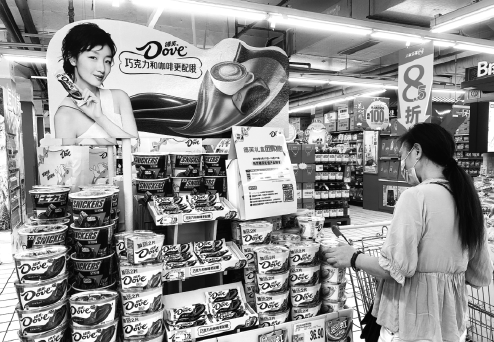Sweeter prospects


Chocolate sales expected to pick up as brands refocus, introduce new products to offset pandemic-induced changes in consumer behavior.
Chocolate makers are offering new flavors, fancy combined textures and hybrid snacks to attract younger consumers via online platforms, in an effort to offset the impact of social distancing on confectionery gifts for Mid-Autumn Festival, which coincides this year with National Day.
Dove, a chocolate brand of United States-based Mars Inc, recently launched four new products, including an eye shadow palette made from chocolates and a doughnut-shaped collection, that target young consumers for gifting and afternoon tea occasions.
In its new branding campaign, Dove has also produced a movie with an all-female cast to encourage young women in China to choose their own work and lifestyle, in line with Mars' vision of creating an inclusive environment for a better future.
"Our holistic innovations in raw material, flavor and packaging and even in storytelling have been tailor-made for Gen Z consumers to attract more attention and add new consumers," said Jelina Wan, marketing vice-president at Mars China Regional.
Ferrero Group, the Italian chocolate and confectionery maker, introduced a new biscuit product, Kinder Happy Hippo, in China in September and said it will bring more new products to the China International Import Expo in November.
Mauro De Felip, general manager of Ferrero China, said festivals and seasonal holidays are among the most important occasions for the chocolate confectionery industry.
Kantar Worldpanel research found that during the first half of this year, amid novel coronavirus restrictions, more investment was allocated for self-consumption products to compensate for the loss of gifting.
Brands including Chocolate X Biscuit have been entering snack markets and offering various cross-border innovations to target more potential shoppers and occasions.
Xue Enyuan, executive director of Bianlifeng convenience stores, said chocolate sales are expected to nearly double in the second half of the year.
Chocolate products in their stores are often priced in a range between 10 yuan ($1.45) and 25 yuan, with those priced between 10 and 15 yuan usually selling the best.
"During festivals in the second half of the year, pricier chocolate in gift packaging will see more sales," said Xue.
Bianlifeng's data show that classic flavors, including milk chocolate and dark chocolate, are the most popular among consumers who are in their 20s or 30s, mostly women.
For chocolate makers, sales have been tempered by social distancing restrictions due to the coronavirus pandemic, leading to fewer gifting occasions and shopping trips, which are top revenue generators.
Indulgence purchases during the coronavirus restrictions did not experience the same panic buying as daily necessities. However, chocolate and snack makers have seen more growth from digital channels and are investing more in digital marketing.
De Felip of Ferrero said COVID-19 had a short-term impact on all industries, including chocolate and confectioneries, in the first half of the year, mainly reflected in the reduction of traffic in brick-and-mortar stores and challenges in logistics and the transportation of goods.
Linh Tay, account manager of Kantar Worldpanel, said that because the Chinese New Year holiday and Valentine's Day are peak times for consumption, the chocolate sector suffered more negative impacts from COVID-19 than most other fast-moving consumer goods categories.
In the first half of the year, the chocolate market declined 18 percent in terms of value-driven mainly by offline channels-and lost more than 3 million household users, compared with the same period in 2019, said Tay.
Gift chocolates experienced the deepest plunge, since travel restrictions and self-quarantine regulations limited the occasions for gifting in urban China, Tay added.
Wan, the Mars marketing vice-president, said: "The epidemic has altered consumers' behaviors and lifestyles, and accelerated the updates from retail suppliers, creating opportunities for Mars in digital innovations and new retail platform expansions.
"Since the beginning of the outbreak of the epidemic, we shifted focus to work with new retail and e-commerce partners and successfully transferred our consumers from offline channels to online platforms," she added.
Dove will focus on self-consumption and marketing through online distribution and cross-category display in stores to attract more consumers. The company has set up a global innovation center for its confectionery products in China.
Meanwhile, online business has seen strong performance among many confectionery brands.
"We have further strengthened our partnership with e-commerce partners to synergize the efforts and initiatives leveraging the new opportunities emerging from a contact-free economy," said De Felip, the Ferrero China general manager.
To increase market potential and enhance its market position in the country, Ferrero, whose products include Ferrero Rocher for premium gifting and Kinder, a snack food brand especially designed for children, has made digital transformation one of its strategic priorities in order to adapt to China's rapidly developing digital economy.
De Felip said the company has deepened partnerships with domestic e-commerce giants including Alibaba and JD.com. On the Tmall Brand Day this year, it launched a Ferrero Rocher limited pack for Mid-Autumn Festival that contains an illustration by a young artist.
Its interaction with the popular bands in the topical show The Big Bands on Sina Weibo has generated enthusiastic social discussions from Weibo users.
"All these efforts, which are aimed to strengthen our communication with the young generation, proved to be a success. The sales revenue of our Tmall flagship store topped in the category in the campaign," he added.
Consumer-centric supply chain reform has brought more accurate marketing for brands and constantly updated products. Through efficient supply chain management, the time for new product research has been greatly shortened in a bid to capture the latest trends and dominate the market.
While it previously took a year or more to develop new products under the Dove brand, development of recent new products took only about four months, said Wan.
Dove also has developed a "consumer to manufacturer to consumer" model that has enabled a 48-hour order-to-delivery experience. Under this model, consumers order customized products online, and within 48 hours, the handmade products are delivered.
Research firm Mintel Group said in a report in July last year that the retail sales value of chocolate confections in China was expected to increase 3 percent in 2019 to 30.7 billion yuan.
This trend was projected to continue over the next five years, with an annual compound growth rate of 3.2 percent. In addition, a rising average retail unit price, rather than retail volume, was expected to be the driving force behind growth, the report said.
It also said international brands continue to play a dominant role in the domestic market, with Mars and Ferrero being the two leading players. The two gained growth in terms of both sales value and volume, with Mars having a 36.7 percent market share in China and Ferrero a 14.3 percent share.
In the next five years, the retail sales value of chocolate will maintain a steady growth rate, with a shift toward healthier ingredients and more nutritious value, according to the Mintel report.
However, research indicates that "traditional indulgence sectors including chocolate have been overshadowed by the playfulness and fun of internet darling products such as milk tea", said Li Chen, deputy director for food and beverage at Mintel.
"Over the years, the mystery and trendy feelings created by international chocolate brands have been gradually vanishing," said Li, with consumers showing a growing preference for healthy, low-calorie products.




































